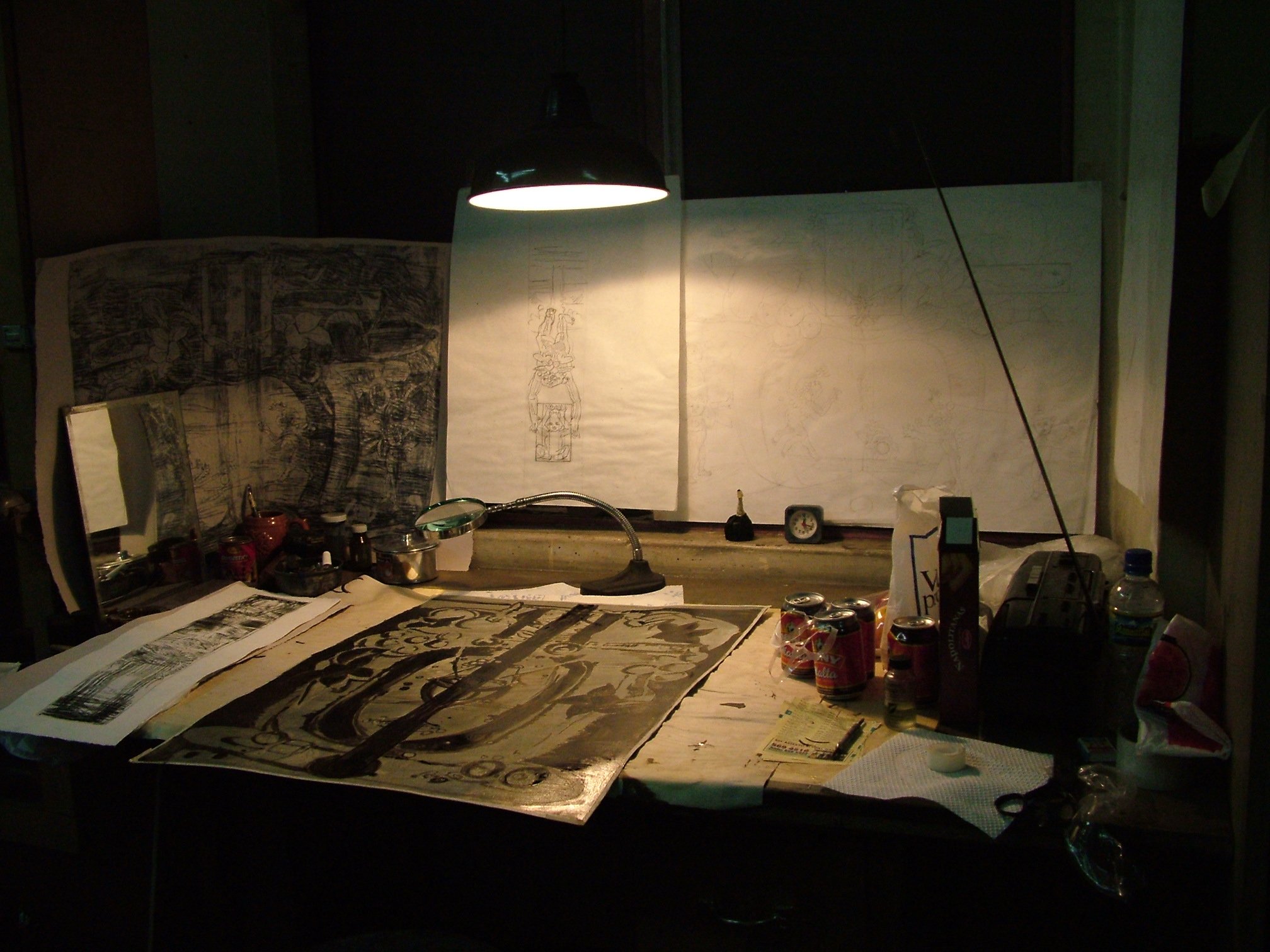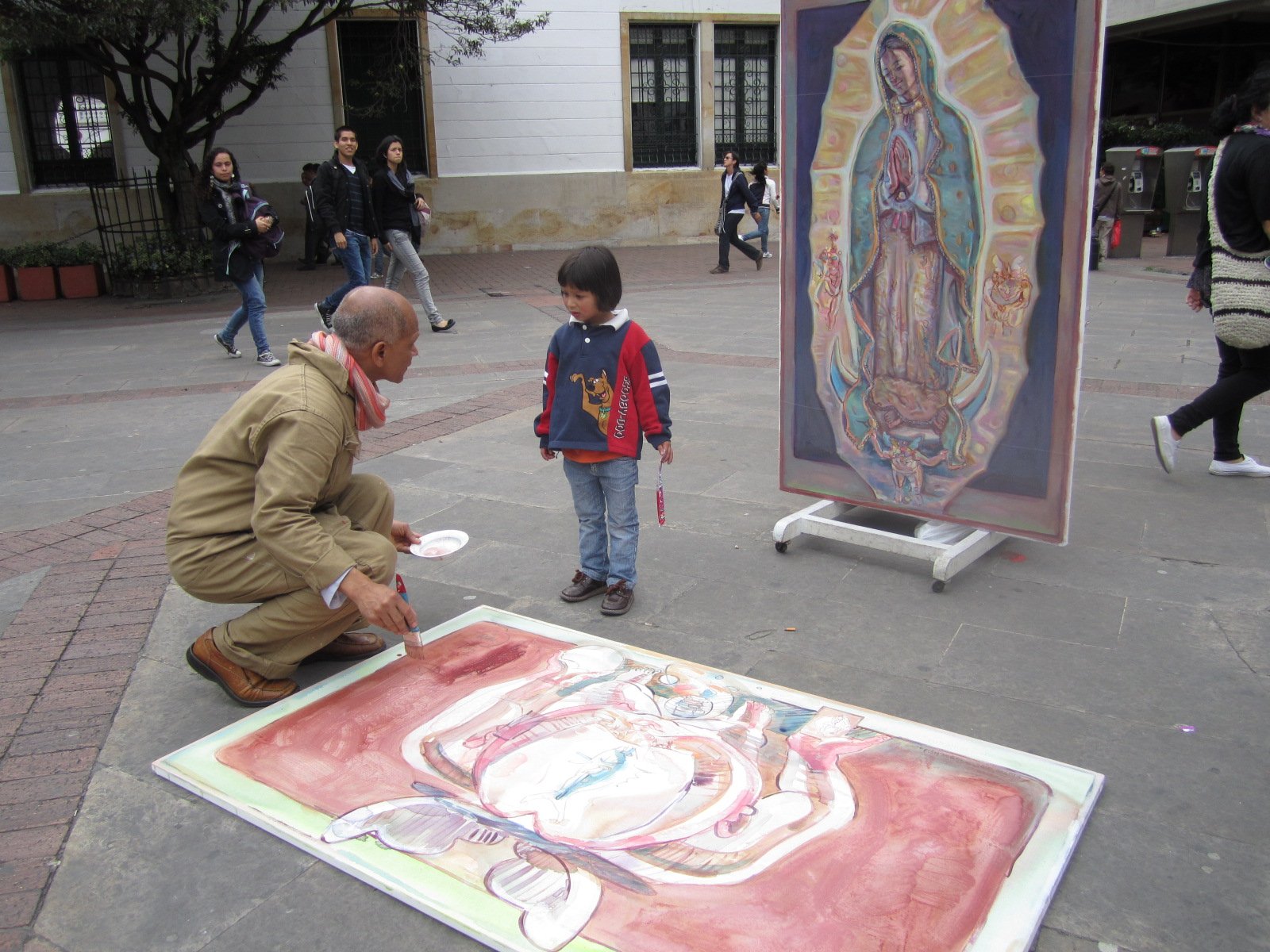Victor Tapias is a Colombian artist whose artistic endeavors range from painting, engraving, and installations to writing and craftsmanship. The following timeline is illustrative of Tapias’s dynamism as an artist. It outlines how his complex and extensive oeuvre sparks, on one hand from lifelong studies of art practices, spirituality, and global history, and on the other, from nuanced observations of his heritage and travels.
In order to even begin to understand Victor Tapias’s work, it is important to be aware of how his artistry is always evolving. His career has three formative pillars: fifteen years of study in the seminary, five years of training in holistic medicine, and sixteen years of academic studies in fine arts. Certain characteristics of his formal style are ever-present and discernible throughout the different stages of his career. But he also builds, and continues to build, on his art by incorporating new experiences he encounters both in his personal and professional life.
1952
Victor Tapias is born in the seaport city of Buenaventura, Colombia. At the age of five he becomes an orphan after the passing of both parents. Soon after he is introduced to painting by a nun and continues to make art as a self-taught artist until he receives mentorship from Monsignor Gerardo Valencia Cano, a restorer of religious icons and imagery at the seminary. By the age of eight, the young Tapias is already skilled in oil painting.
1968
Starts exhibiting his work in Colombia.
1972
Tapias relocates to Bogotá, where he studies, works, and exhibits. He works as a cartoonist in the newspaper El Tiempo with the cartoonist Merino. He also participates in a variety of publicity campaigns including Cine Colombia. He exhibits at the Museum of Art and Popular Tradition and at the gallery of Doris Angel. He also begins showing his paintings in Lima, Peru and decides to move temporarily to Lima. There, he works with Fernando de Szyszlo, a Peruvian painter, sculptor, and printmaker who was a prominent figure in the Latin American abstraction scene.
1974 - 1978
During these years Tapias exhibits his art throughout South America and takes part in the Latin American plastic arts movement, working with artists such as Oswaldo Guayasamín and Fernando de Szyszlo. He studies drawing at the National University of San Marcos in Lima, Peru. In this period he completes two interior murals. One at the Association of Employees of the Bank of the Republic (ANEBRE) honoring Ricardo Carmona and a second one at the labor union of Avianca Airlines.
1981
He completes his first major engraving in the workshop of master engraver Umberto Giangrandi.
1982
Completes the engraving Stephanie Born, which he created as a tribute to the birth of his second daughter, Brisa Estefania. The engraving receives recognition in the Seventh Latin American Biennial of Graphic Arts and becomes one of his most celebrated pieces. President Belisario Betancur acquires it for his private collection at the presidential residence in the Nariño Palace.
1985
Travels to Buenaventura to accept an award during the celebration of the city’s 445th anniversary. While in Buenaventura, he completes two murals: Portraits of the Sea in the Iana Celli Building and Union of Marines of the Merchant Fleet “Great Colombian” at UNIMAR.
1976 – 1986
In this period he completes his studies at the National University of Colombia. In 1980 he creates the mural Rebirth, exalting the overlooked but virtuous spirituality of the student movements. The mural is later designated a site of cultural and historical patrimony of the university.
Tapias moves to Moscow, Russia for some time and studies engraving at the Pushkin State Museum of Fine Arts.
Back in Colombia, he establishes his own workshop with the master engraver Umberto Giangrandi. He also works with other national avant-garde artists such as Alejandro Obregón, Enrique Grau, Santiago Cárdenas, Luis Paz, Angel Loochkartt, Armando Villegas, and others. He meets the artist Fernando Botero through the art dealer, Byron Lopez.
The president of Colombia, Belisario Betancur, calls him the “eternal traveler.” Inspired by the remark, he begins developing the concept of Color Moreno, a concept which had flourished from his constant traveling and the racial melting pot that is Colombia. The idea remains at the core of his artwork throughout the rest of his career. The president names him Cultural Ambassador to disseminate his pictorial work across the continent, especially his Childhood Series, and promote art in and about Colombia. This project eventually takes the form of the FIN Brotherhood.
He exhibits his seminal artwork, A Child Great As Man (1980), and a series of eighteen paintings across Central America in Guatemala, Honduras, Nicaragua, Costa Rica and Panama. He donates the series to different public figures in the region and non-profit organizations including UNICEF. In Panama, he has the opportunity to work with local artists such as Alfredo Sinclair, Manuel Chong Neto, Guillermo Trujillo, and Bruce Alfaro.
1987 - 1992
Tapias travels and lives in New York and the Caribbean. The artist also makes a trip to Paris, France. While traveling, he writes a collection of Meditations, reflecting on his artwork, mission, and vision.
In New York City he studies at the Engraving League and the Pratt Institute. He exhibits pieces on Color Moreno and the Childhood Series at Governor Mario Cuomo’s residence.
He travels and exhibits in Puerto Rico for the Seventh Biennial of Latin American and Caribbean Engraving. Among the pieces is Stephanie Born (1982). He spends some time living and exhibiting in Puerto Rico, Jamaica, Haiti, and the Dominican Republic.
He works more extensively on the representation and theory of Color Moreno and holds conferences on the subject in several universities. He donates some of his work to the Institute of Puerto Rican Culture and also gifts some work to Governor Hernandez Colón of Puerto Rico.
In 1992 Tapias writes the book The Loving Color: The Principle of Moreno Color. In this text he ponders on race and social integration. This is a formative period for the artist. He also writes manifestos on the spiritual origin of art and studies chromotherapy, a branch of art therapy that uses color to adjust body vibrations in order to promote wellness and harmony.
1993
Arrives in Miami from Puerto Rico and establishes the FIN Brotherhood and the Temple Fine Arts Center International after presenting the project at the Consulate of Colombia. He holds three simultaneous exhibitions at Fenix Fine Arts, the Consulate of Colombia, and the Florida Museum of Hispanic and Latin America Art.
1995 – 2001
During these years he is based in Miami, Florida and mainly focuses on establishing and managing the Temple Fine Art Center International. In 1997 Tapias travels to India and Nepal. As a result of his travels to Asia he starts working on his mystical and spiritual practice more closely, developing his text Art as Nutrition for Sanity.
2002
Tapias visits Valleta, Malta where he is inspired to write The Painter and the Spaceship, based on the historical fable, “The Painter and the Ship.” He works in his Angel Series and writes a manifesto on the topic of childhood.
2003
Starts writing his book Nine Bodies.
2005
This year he exhibits his work on Childhood, Doors and Visions. He paints Sasha Light in tribute to President Barack Obama’s youngest daughter.
He participates in Art Basel in Miami in association with several galleries, Florida International University, and the Consulate of Colombia in Miami.
2008
Continues working on exhibitions commemorating his forty-five years of labor in the arts, emphasizing his work on and about Color Moreno.
2010 - 2020
After many years, the artist returns to his home country and exhibits his work at the Enrique Grau Foundation and many other sites and institutions in Colombia. He introduces his Angels Series, unveils the mural Angel, Virtue of Peace, and starts working on the series Leaf of a Tree. For this project, Tapias paints directly on the fallen leaves of the seagrape tree.
During this trip to Colombia, after having been away for years, Tapias reflects on the urgent need to use art as a motivating light in the pursuit of human welfare. His pictorial work is an expression of his personal vision and mission. He applies his understanding of chromotherapy to his treatment of Color Moreno and as he revisits his Childhood Series. He perceives spirituality and art as interwoven forces. As a result of the hardships he had to endure during his own childhood, he devotes his career to promoting the value and sanctity of childhood. The artist believes that approaches rooted outside of politics and religion, such as art techniques, are the bridge between the virtues deep within humans, so apparent in childhood, and the divine.
Currently, living between Miami and Colombia, Tapias continues to expand on the integration of art therapy, Color Moreno, and pictorial expression.





